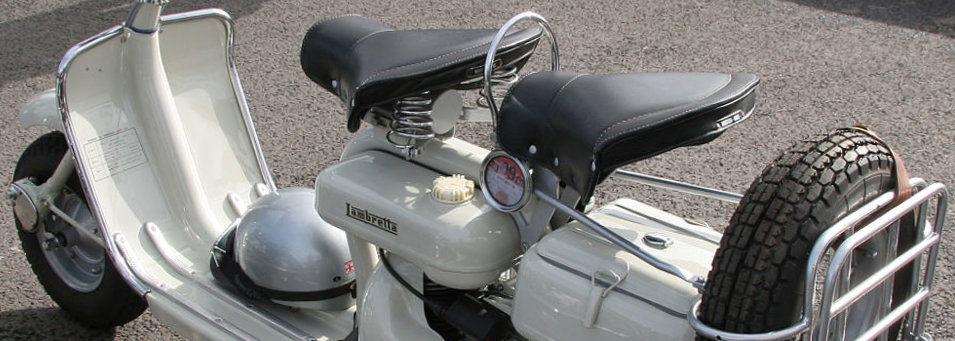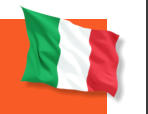
















Creation of Ferdinando Innocenti

Lambretta 125 - 1953
Lambretta was a line of motor scooters originally
manufactured in Milan, Italy, by Innocenti. In 1972, the
Indian government bought the Milanese factory and the
rights to the Lambretta name, creating Scooters India
Limited (SIL).
Today, the Innocenti brand name rights are owned by Fiat whereas the oldest Lambretta and Lambro trademark registrations worldwide are owned by SIL. Lambretta scooters were also
Lambro trademark registrations worldwide are owned by SIL. Lambretta scooters were also manufactured under licence by Fenwick in France, NSU in Germany, Serveta in Spain, API in
manufactured under licence by Fenwick in France, NSU in Germany, Serveta in Spain, API in India, Yulon in Taiwan, Pasco in Brazil, Auteco in Colombia and Siambretta in Argentina.
India, Yulon in Taiwan, Pasco in Brazil, Auteco in Colombia and Siambretta in Argentina.
History
In 1922, Ferdinando Innocenti of Pescia built a steel-tubing factory in Rome. In 1931, he took the business to Milan where he built a larger factory producing seamless steel tubing and
the business to Milan where he built a larger factory producing seamless steel tubing and employing about 6,000. The factory was heavily bombed and destroyed during World War II.
employing about 6,000. The factory was heavily bombed and destroyed during World War II. It is said that surveying the ruins, Innocenti saw the future of cheap, private transport and
It is said that surveying the ruins, Innocenti saw the future of cheap, private transport and decided to produce a motor scooter, competing on cost and weather protection against the
decided to produce a motor scooter, competing on cost and weather protection against the ubiquitous motorcycle.
ubiquitous motorcycle.
Concept
The main stimulus for the design style of the Lambretta and Vespa dates back to pre-World War II Cushman scooters made in Nebraska, United States. These olive green scooters were in
War II Cushman scooters made in Nebraska, United States. These olive green scooters were in Italy in large numbers, ordered originally by the United States military as field transport for
Italy in large numbers, ordered originally by the United States military as field transport for the paratroops and marines. The United States military had used them to get around German
the paratroops and marines. The United States military had used them to get around German defence tactics of destroying roads and bridges in the Dolomites (a section of the Alps) and
defence tactics of destroying roads and bridges in the Dolomites (a section of the Alps) and the Austrian border areas.
Aeronautical engineer General Corradino D'Ascanio, responsible for the design and
the Austrian border areas.
Aeronautical engineer General Corradino D'Ascanio, responsible for the design and construction of the first modern helicopter by Agusta, was given the job by Ferdinando
construction of the first modern helicopter by Agusta, was given the job by Ferdinando Innocenti of designing a simple, robust and affordable vehicle. It had to be easy to drive for
Innocenti of designing a simple, robust and affordable vehicle. It had to be easy to drive for both men and women, be able to carry a passenger and not get its driver's clothes soiled.
both men and women, be able to carry a passenger and not get its driver's clothes soiled.
The design
D'Ascanio, who hated motorbikes, designed a revolutionary vehicle. It was built on a spar frame with a handlebar gear change and the engine mounted directly onto the rear wheel.
frame with a handlebar gear change and the engine mounted directly onto the rear wheel. The front protection "shield" kept the rider dry and clean in comparison to the open front
The front protection "shield" kept the rider dry and clean in comparison to the open front end on motorcycles. The pass-through leg area design was geared towards women, as
end on motorcycles. The pass-through leg area design was geared towards women, as wearing dresses or skirts made riding conventional motorcycles a challenge. The front fork,
wearing dresses or skirts made riding conventional motorcycles a challenge. The front fork, like an aircraft's landing gear, allowed for easy wheel changing. The internal mesh
like an aircraft's landing gear, allowed for easy wheel changing. The internal mesh transmission eliminated the standard motorcycle chain, a source of oil and dirt. This basic
transmission eliminated the standard motorcycle chain, a source of oil and dirt. This basic design allowed a series of features to be deployed on the frame which would later allow
design allowed a series of features to be deployed on the frame which would later allow quick development of new models.
quick development of new models. However, D'Ascanio fell out with Innocenti, who rather than a stamped spar frame wanted to
However, D'Ascanio fell out with Innocenti, who rather than a stamped spar frame wanted to produce his frame from rolled tubing, allowing him to revive both parts of his pre-war
produce his frame from rolled tubing, allowing him to revive both parts of his pre-war company. D'Ascanio disassociated himself from Innocenti and took his design to Enrico Piaggio
company. D'Ascanio disassociated himself from Innocenti and took his design to Enrico Piaggio who produced the spar-framed Vespa from 1946 on. The final design of the Lambretta was
who produced the spar-framed Vespa from 1946 on. The final design of the Lambretta was done by aeronautical engineers Cesare Pallavicino and Pier Luigi Torre. Pallavicino had been
done by aeronautical engineers Cesare Pallavicino and Pier Luigi Torre. Pallavicino had been Technical Director at the Caproni airplane factory during World War II before working on the
Technical Director at the Caproni airplane factory during World War II before working on the Lambretta design. Torre was an engine designer at Italo Balbo's Idros; he designed the engine
Lambretta design. Torre was an engine designer at Italo Balbo's Idros; he designed the engine and organized Innocenti's factory for mass production.
and organized Innocenti's factory for mass production.
Into production
Taking a year longer to produce, the 1947 Lambretta featured a rear pillion seat for a passenger or optionally a storage compartment. The original front protection "shield" was a
passenger or optionally a storage compartment. The original front protection "shield" was a flat piece of aero metal; later this developed into a twin skin to allow additional storage
flat piece of aero metal; later this developed into a twin skin to allow additional storage behind the front shield, similar to the glove compartment in a car. The fuel cap was
behind the front shield, similar to the glove compartment in a car. The fuel cap was underneath the hinged seat, which saved the cost of an additional lock on the fuel cap or
underneath the hinged seat, which saved the cost of an additional lock on the fuel cap or need for additional metal work on the smooth skin.
need for additional metal work on the smooth skin. Deriving the name Lambretta from the small river Lambro in Milan, which ran near the
Deriving the name Lambretta from the small river Lambro in Milan, which ran near the factory, Innocenti started production of Lambretta scooters in 1947, the year after Piaggio
factory, Innocenti started production of Lambretta scooters in 1947, the year after Piaggio started production of its Vespa models. Lambrettas were manufactured under licence in
started production of its Vespa models. Lambrettas were manufactured under licence in Argentina, Brazil, Chile, Colombia, India and Spain, sometimes under other names, but
Argentina, Brazil, Chile, Colombia, India and Spain, sometimes under other names, but always to a recognizable design, e.g. Siambretta in South America and Serveta in Spain.
always to a recognizable design, e.g. Siambretta in South America and Serveta in Spain.
BLMC closure of Innocenti
As wealth increased in western Europe in the late 1960s, the demand for motor scooters fell as the small car became available to more people and Lambretta started to struggle
as the small car became available to more people and Lambretta started to struggle financially, as did parent Innocenti. The British Leyland Motor Corporation took advantage of
financially, as did parent Innocenti. The British Leyland Motor Corporation took advantage of Innocenti's financial difficulties and their production and engineering expertise and
Innocenti's financial difficulties and their production and engineering expertise and contracted Innocenti to produce cars under licence from BLMC. The Innocenti Mini used the
mechanical components of the original, but was in many ways superior to it.
contracted Innocenti to produce cars under licence from BLMC. The Innocenti Mini used the
mechanical components of the original, but was in many ways superior to it. Innocenti/Lambretta was eventually sold to BLMC. Unfortunately, lack of foresight had
Innocenti/Lambretta was eventually sold to BLMC. Unfortunately, lack of foresight had caused BLMC to join a fashion trend that was ending rapidly. Long industrial strikes in BLMC
caused BLMC to join a fashion trend that was ending rapidly. Long industrial strikes in BLMC ensued; motor-scooter sales declined sharply, and both Innocenti and Lambretta closed shop
ensued; motor-scooter sales declined sharply, and both Innocenti and Lambretta closed shop in 1972.
in 1972. The Indian government bought the factory for essentially the same reasons that Ferdinando
The Indian government bought the factory for essentially the same reasons that Ferdinando Innocenti had built it after the war. India was a country with poor infrastructure,
Innocenti had built it after the war. India was a country with poor infrastructure, economically not ready for small private cars yet with a demand for private transport.
economically not ready for small private cars yet with a demand for private transport. Automobile Products of India (API) began assembling Innocenti-built Lambretta scooters in
Automobile Products of India (API) began assembling Innocenti-built Lambretta scooters in India after independence in the 1950s beginning with 48 cc, Ld model, Li 1st series. They
India after independence in the 1950s beginning with 48 cc, Ld model, Li 1st series. They eventually acquired a licence to build the Li150 Series 2 model, which was sold under the
eventually acquired a licence to build the Li150 Series 2 model, which was sold under the Lambretta name until about 1976 and later on changed the name to Lamby for legal reasons.
Lambretta name until about 1976 and later on changed the name to Lamby for legal reasons. They also for sometime made and sold Lambretta TV 175 series under the name of Mac 175.
They also for sometime made and sold Lambretta TV 175 series under the name of Mac 175. Scooter India Ltd acquired the entire Innocenti Unit in 1972. API also built the trademark
Scooter India Ltd acquired the entire Innocenti Unit in 1972. API also built the trademark model [API-175] three-wheeler which was based on Innocenti's Lambro. API continued to
model [API-175] three-wheeler which was based on Innocenti's Lambro. API continued to build Lambretta-derived models until the 1990s but have been non-operational since 1993.
build Lambretta-derived models until the 1990s but have been non-operational since 1993. In 1972, Scooters India Ltd. (SIL) a state-run enterprise based in Lucknow, Uttar Pradesh,
In 1972, Scooters India Ltd. (SIL) a state-run enterprise based in Lucknow, Uttar Pradesh, bought the entire Lambretta manufacturing and trademark rights. Former Innocenti
bought the entire Lambretta manufacturing and trademark rights. Former Innocenti employees were used to set up an Indian factory as all the manuals and machinery
employees were used to set up an Indian factory as all the manuals and machinery instructions were in Italian. The first scooter built was the Vijay Delux/DL, which was badged
instructions were in Italian. The first scooter built was the Vijay Delux/DL, which was badged the Lambretta GP150 in export markets. This was later enhanced to become the Vijay Super.
the Lambretta GP150 in export markets. This was later enhanced to become the Vijay Super. Further improvements were made in the final years of production by incorporating a
Further improvements were made in the final years of production by incorporating a contemporary Japanese CDI unit and an advanced front suspension. SIL also distributed
contemporary Japanese CDI unit and an advanced front suspension. SIL also distributed complete knock downs that were assembled in different parts of India and sold as the Allwyn
complete knock downs that were assembled in different parts of India and sold as the Allwyn Pusphak, Falcon, and Kesri. These were of a lower quality than the SIL-produced models and
Pusphak, Falcon, and Kesri. These were of a lower quality than the SIL-produced models and sometimes incorporated significant styling changes.
sometimes incorporated significant styling changes. SIL production seems to have peaked during the financial year 1980–81, with around 35,000
SIL production seems to have peaked during the financial year 1980–81, with around 35,000 scooters being built. However, by 1987 this had dropped to around 4,500 units with
scooters being built. However, by 1987 this had dropped to around 4,500 units with production finally ceasing in 1997. As of 2011, SIL's production now centres on the Vikram 3-
production finally ceasing in 1997. As of 2011, SIL's production now centres on the Vikram 3- wheeler, powered by the Lambretta engine. SIL also produces limited spares for the GP/DL
wheeler, powered by the Lambretta engine. SIL also produces limited spares for the GP/DL range of scooters.
range of scooters.
Current production
In 2010 Lambretta returned to 125 Grand Prix racing in order to gain publicity for its new range of scooters. This was the LN range, launched in 2011, with styling inspired by earlier
range of scooters. This was the LN range, launched in 2011, with styling inspired by earlier models. These scooters are assembled in Taiwan by SYM Motors and use their single-cylinder
models. These scooters are assembled in Taiwan by SYM Motors and use their single-cylinder "twist and go" engine and transmission unit. However, the scooter's steel body panels are
"twist and go" engine and transmission unit. However, the scooter's steel body panels are manufactured in Italy.
manufactured in Italy.
Legacy
There are still clubs across the world, both national and local clubs, devoted to the Lambretta scooter. The clubs still participate and organize ride outs and rallies which
Lambretta scooter. The clubs still participate and organize ride outs and rallies which regularly take place during weekends over the summer months and have high attendance,
regularly take place during weekends over the summer months and have high attendance, some rallies achieve 2,500 paying rally goers. Across the UK there are many privately owned
some rallies achieve 2,500 paying rally goers. Across the UK there are many privately owned scooter shops which deal with everything Lambretta, from sales, services, parts, tuning,
scooter shops which deal with everything Lambretta, from sales, services, parts, tuning, performance and complete nut and bolt restorations.
In Brazil, “lambreta” is used as a synonym for “scooter”, being listed at the Novo Dicionário
performance and complete nut and bolt restorations.
In Brazil, “lambreta” is used as a synonym for “scooter”, being listed at the Novo Dicionário da Língua Portuguesa, one of the country’s main dictionaries, as a noun/substantive.
The small village of Rodano, near Milan, hosts the biggest Lambretta museum in Europe and
da Língua Portuguesa, one of the country’s main dictionaries, as a noun/substantive.
The small village of Rodano, near Milan, hosts the biggest Lambretta museum in Europe and the Innocenti archives. In the collection are also several non-Lambretta scooters, including
the Innocenti archives. In the collection are also several non-Lambretta scooters, including some first models from the 1910s and US Army scooters parachuted over Normandy in 1944.
some first models from the 1910s and US Army scooters parachuted over Normandy in 1944. In Weston-super-Mare, England, there is a Lambretta Scooter Museum which houses a total of
61 Lambretta models – at least one from each year between October 1947 through to May
In Weston-super-Mare, England, there is a Lambretta Scooter Museum which houses a total of
61 Lambretta models – at least one from each year between October 1947 through to May 1971. It also houses a large amount of Lambretta memorabilia. This museum and collection
1971. It also houses a large amount of Lambretta memorabilia. This museum and collection was sold in early 2007 and re-opened on 8 August 2008 following refurbishment.
was sold in early 2007 and re-opened on 8 August 2008 following refurbishment. In 1997 the UK-based Lambretta Clothing brand of clothing and accessories was founded.
In 1997 the UK-based Lambretta Clothing brand of clothing and accessories was founded.

1953
 Engine
125 cc
2-stroke
Engine
125 cc
2-stroke


Photos mainly by Matti Kreivilä. Historical facts and technical details of the vehicles provided by Wikipedia. Movies YouTube.











